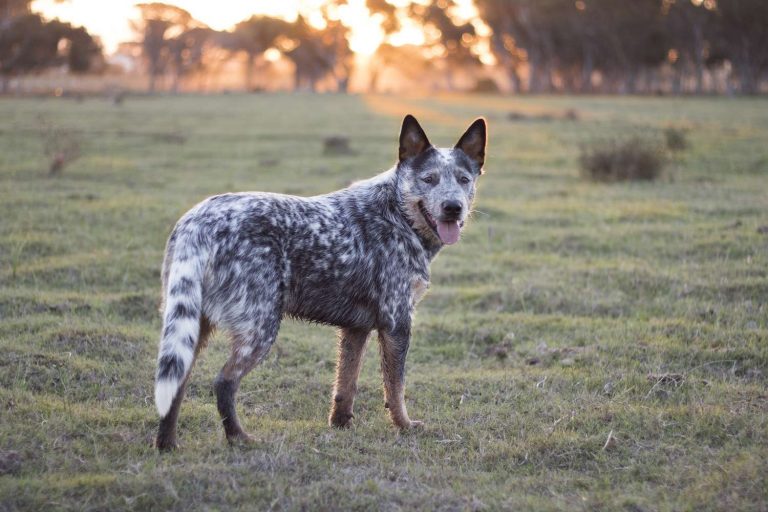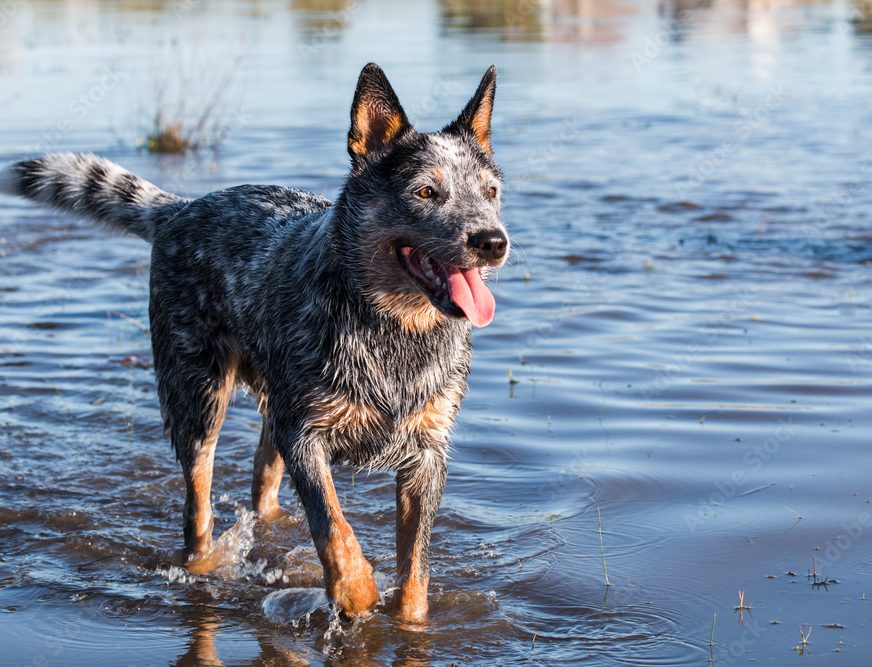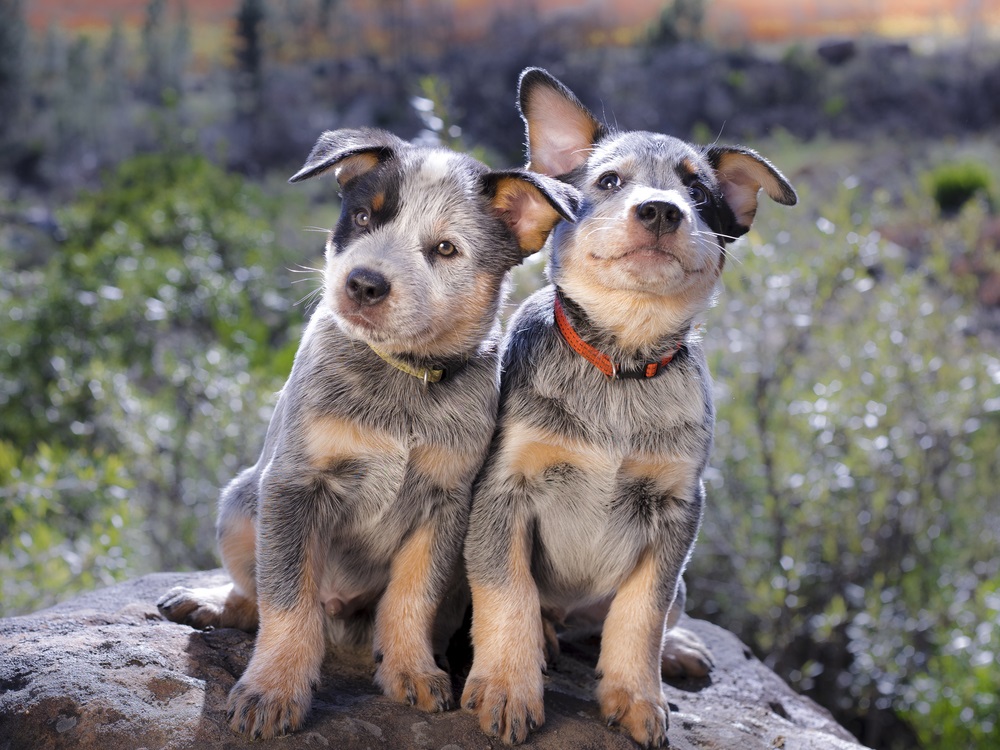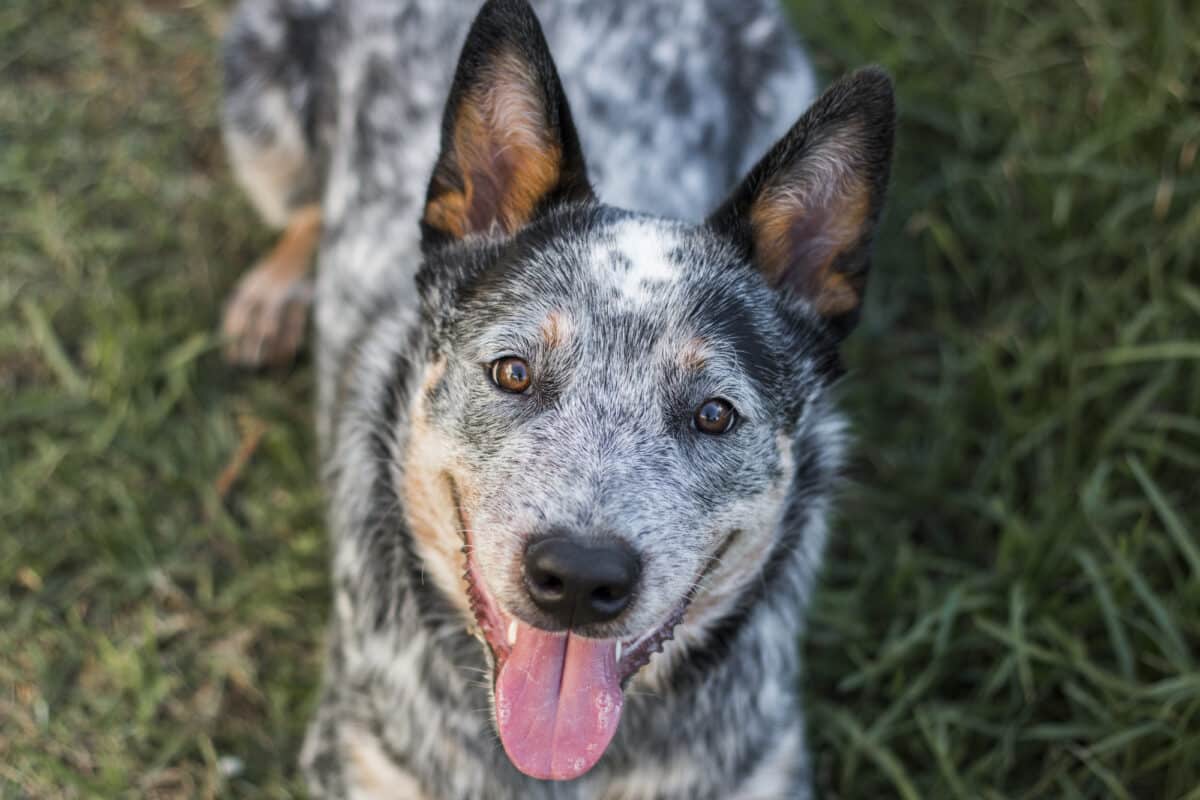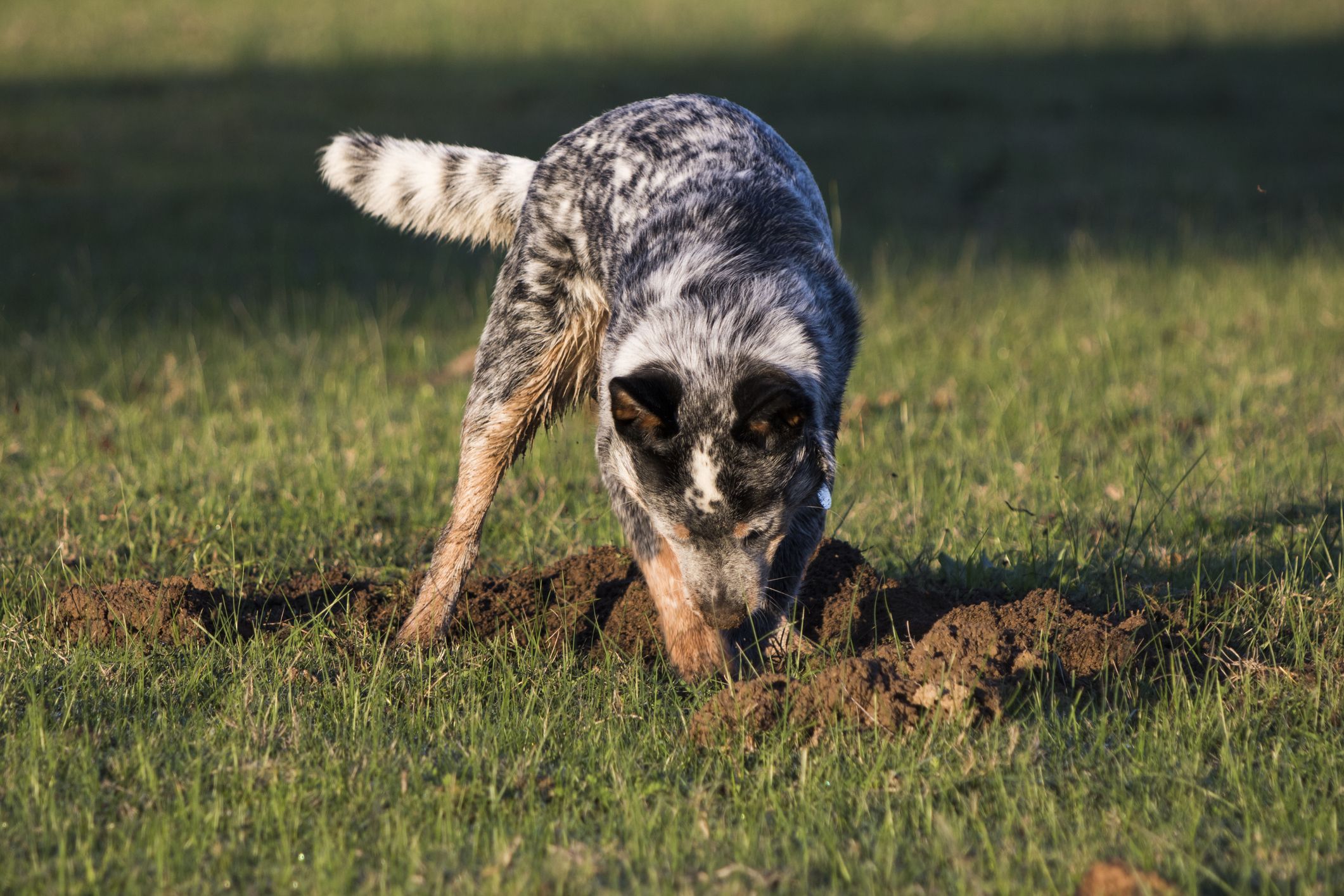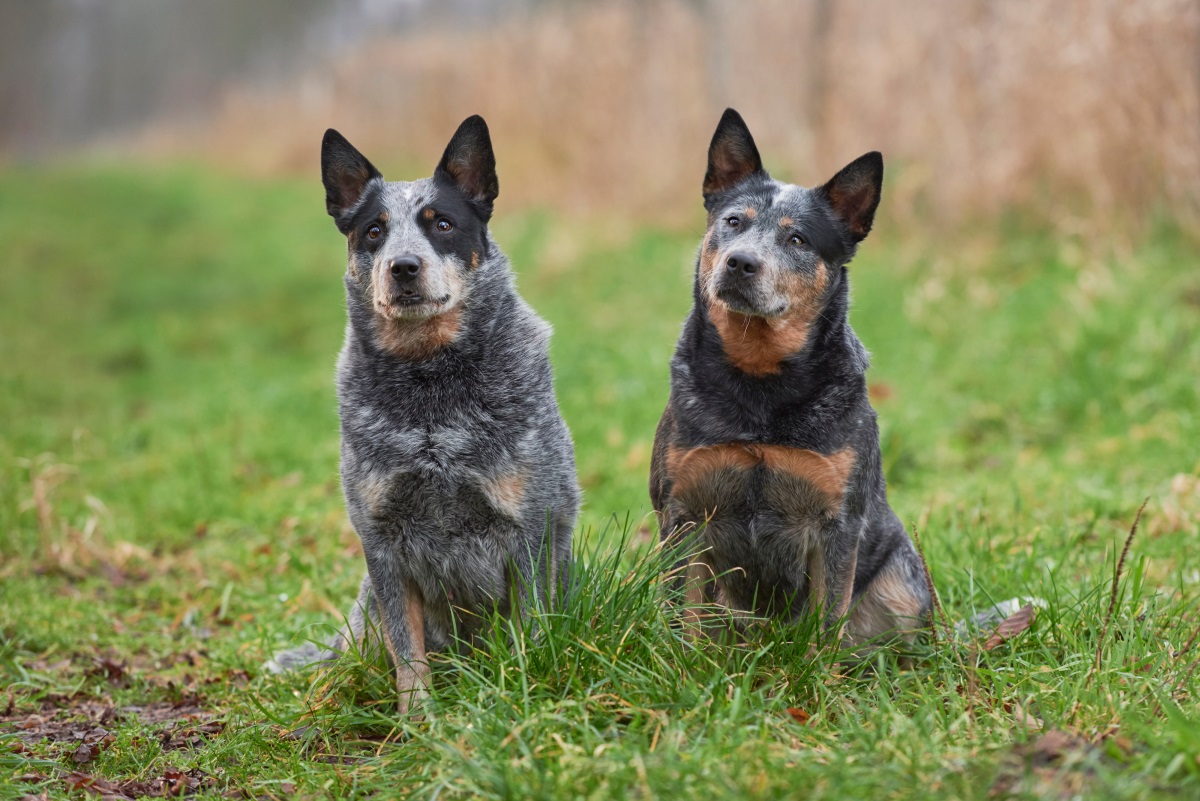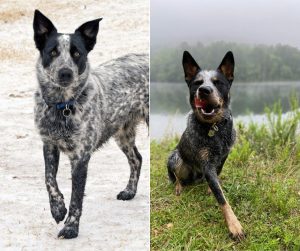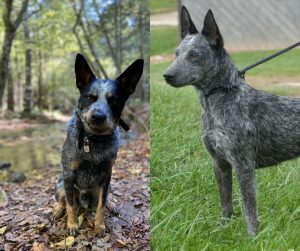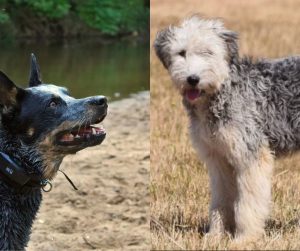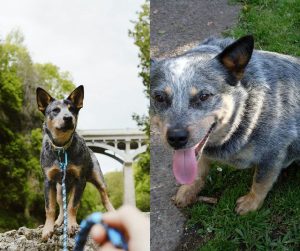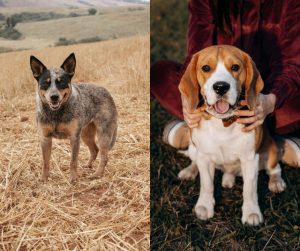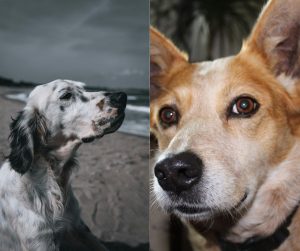Australian George Elliot developed the Australian Cattle Dog in 1840 by mixing native dingoes with Collies and other herding dog breeds. Some people know the breed by the name Blue Heeler, Australian Heeler, Hal Heeler, and Queensland Heeler. No matter the name, the Australian Cattle Dog is an amazing herding breed. But that is not all.
Do you want to know some Blue Heeler facts? Let’s take a look.
Breed ID
Origin: Australia
Size: 17 to 20 inches
Weight: 35 to 45 pounds
Lifespan: 13 to 15 years
Group: Herding group
Breed Overview
Blue Heelers are solid, sturdy, and compact dogs that have an alert and ready-to-work stance. They are slightly longer than tall with a curved and hanging tail. Their name refers to the blue coat, while the red-coated Australian Cattle Dog is known as Red Heeler.
The sturdy, medium-sized herding dog breed was developed in Australia in the late 1800s. Their dense double coat consists of a thick undercoat and a short, weather-resistant overcoat.
They are famous as a hard-working and intelligent breed, one that is extremely loyal to its owner. Historically, they were bred to work on farms as herders. To this day, they thrive when they have a job to do. Yet, nowadays, the Blue Heeler has evolved into being more than just a farm dog.
They love to have a job to do and can do things like figuring out puzzles or retrieving toys.
Simply put, the Australian Cattle Dog is an all-purpose pet. Most shepherd breeds are famous as family pets, and the Blue Heeler is not an exception to this rule. They are naturally social, obedient, and smart, getting along with other animals by definition.
Nowadays, despite being a family pet and a herding breed, these dogs have been utilized as hunting companions, used mostly for locating and retrieving.
They are known for having an unwavering work ethic and have become intensely devoted to their owners. They do not like when they are separated from their owners. Many people call them shadow dogs or Velcro dogs because they follow you anywhere you go. Like your trusted shadow.
History
Here is an interesting fact. Two names are synonymous with developing Australian Cattle Dog. The first one is George Elliot, and the second one is Thomas Hall. The second is the reason why these puppies are known as Halls Heeler.
The first theory goes that in 1840, George Elliot, in Queensland, experimented with Australian Dingo-blue Merle Collie crosses. His dogs produced excellent workers. Cattlemen were impressed with the working ability of the new breed and purchased puppies as they became available.
Two brothers, Jack and Harry Bagust of Sydney, purchased some of the dogs and set about improving them. They wanted to cross them with an imported Dalmatian, with the cross resulting in blue and red speckles. Their goal was to instill the love of horses and faithfulness to master into their dogs.
They kept only the puppies closest to the ideal and became the forebears of the present-day Australian Cattle Dog. The working ability of these dogs was outstanding, retaining the quiet heeling and ability and stamina of the Australian Dingo, with the protectiveness of the Dalmatian. In 1893, Robert Kaleski took up breeding the dogs and began showing them in 1897.
The second theory is about the farmer called Thomas Hall. He crossbred dogs that were being used as drovers from Northumberland with tamed Dingos. There is no information on which English dogs he used.
Hall felt that the English dogs were not suited for the working conditions in the harsh Australian country and dealing with semi-wild cattle. He felt that cattle in Australia were different than cattle in England, so he used native Dingos to come up with the Halls Heeler.
In 1825, he successfully bred the first Australian Cattle Dog. By 1832, he had a couple of dogs, and it was the first time a wild dog was bred with a domestic dog. Following his death in 1870, his dogs became available for the first time. But after his death, the records he had kept of his breeding program disappeared.
No matter which theory is true, we know that Robert Kaleski was the first person to author the published breed standard for the Australian Cattle Dog. He set the acceptable appearance and temperament of the breed.
The dog appeared in the United States for the first time in the mid-1900s. The American Kennel Club recognized the breed in 1980, placing him in the working group initially. Yet, by 1983, they were moved into the herding group.
Appearance
The general appearance of the Blue Heeler breed is a strong, compact, and symmetrically built working dog. They have the ability and willingness to carry out tasks with a combination of power, substance, balance, and hard muscular condition.
Now, speaking of their head, it is strong and must be in balance with other proportions of the dog and keep with its general conformation. The broad skull of the Blue Heeler is slightly curved between the ears, flattening to a slight but definite stop.
Ears should be of moderate size, preferably small rather than large, and broad at the base. The mouth should have evenly spaced teeth, gripping with a scissor-bite, with the lower incisors close behind and just touching the upper. The neck is extremely strong, muscular, and of medium length.
The length of the body from the point of the breast bone, in a straight line to the buttocks, should be greater than the height at the withers. The ratio is 10 to 9, with the topline level, back strong with ribs well sprung and carried well back.
These dogs have a smooth coat, but it is a double coat with a dense undercoat. Colors depend on whether you have a Blue Heeler or Red Heeler. Permissible markings are black, blue, or tan on the head, evenly distributed. Blue should be blue mottled or blue speckled, with or without markings.
These dogs grow between 17 and 20 inches at withers, reaching weight between 35 and 50 pounds.
Temperament
When we talk about the Blue Heeler, we have to mention that this canine is an extremely active dog who needs constant physical and mental activity. When he is bored or lonely, he can turn into destructive behavior.
While temperament can be affected by several factors, like training, socialization, and heredity, here are some personality traits of the Australian Cattle Dog. Before we go there, if you can choose from the litter, here is a tip. Choose the middle-of-the-road puppy, not the one who is beating up his littermates or the one who is hiding in the corner. Always meet at least one of the parents if possible.
- Protective of what he considers his territory, and he will do anything to defend it
- Reserved, but not unfriendly with strangers. This dog is devoted to its owner and family but needs time to warm up to strangers
- While he is incredibly smart, sometimes, he can be willful and stubborn
- This high-energy dog needs plenty of exercise, do not expect him to turn into a couch potato. This dog wants and needs to be active and busy for most of the day
- Highly devoted to the family and dog owner, he will attach himself closely to one person in the family, and bond less closely with others. That is why people often call him a Velcro dog
- Bred to herd with force, he is a mouthy dog. His instinct is to nip cattle, children, pets, and anything that moves. Blue Heelers tend to bite, so make sure you teach them bite inhibition
- These puppies have a strong prey drive, and they are often fascinated by squirrels, cats, and small animals
- There is a toughness in his character, meaning he was taught to handle the high temperature, rough terrain, and long distance. Because of it, he is highly tolerant of pain and intensely focused. This dog will keep working even when he is injured
- While he is an amazing family pet, he does best when raised with children and accepts them as part of the pack and household. In that case, he will be playful and protective. You have to pay attention to training because of the dog’s tendency to nip and bite
- The Blue Heeler gets along with other dogs in the household when raised from puppyhood. Because he is devoted to one person in the family, he might get jealous if there is another puppy getting too much attention from his dog owner
How Do They Herd?
A huge part of the temperament of your Blue Heeler is their herding instinct. So, how do these dogs herd? If you wondered why they are called heelers, we will try to explain. It is all because of their herding technique. This might come as a surprise, but not all herding dog breeds herd the same.
For example, Border Collies tend to stalk sheep and stare them down with intense eyes. Then, the New Zealand Huntaway uses its loud, deep bark to drive sheep.
But the Australian Cattle Dog uses a technique to nip at the heels of the sheep. Because they tend to bite the heels of livestock, these dogs are nicknamed Heelers.
Training
Now let’s talk about training an Australian Cattle Dog. Is it hard? Are these dogs easy to train?
Well, when you think of their dedication to work, you might think they are easy to train. And that is partly true.
When it comes to training, the trick here is to make sure your dog has a job to do. But that sounds easier than it is in practice. These dogs need to work 24×7.
If you do not provide enough mental stimulation and work, they will find it on their own. What does that mean? Well, you should combine training with some games, which will make sure your dog burns its energy.
They do have a stubborn streak and can become wilful. But that is only if you do not raise your game on their intellectual level.
Exercise Needs
As with many other working dogs and herding dog breeds, the Australian Cattle Dog needs plenty of physical exercise. Generally talking, they need between 60 and 90 minutes of physical exercise and mental stimulation per day.
Now, that is not what you can easily provide. If you do not have time and effort to make sure your Blue Heeler puppy is taken care of, I suggest getting another dog.
You can make things easier by having a house with a big yard. That will allow your dog to run around and roam. But make sure to fence it properly.
Health Issues
Generally speaking, Blue Heelers are powerful and athletic dogs. They are among the healthiest dogs in the canine world. Yet, they still suffer from some health problems. Most importantly, their joints and ligaments can undergo some wear and tear because of their constant running. Here are some common health issues targeting the Blue Heeler dog breed.
- Canine hip dysplasia, often resulting in limping, bunny hopping, and avoidance of physical activity
- Progressive retinal atrophy, an eye condition that can sometimes result in impaired vision. You can notice it mostly at night. If your dog has enlarged pupils at night, you should do something. While the retinal atrophy is painless, it can lead to complete blindness
- These dogs are also at risk of deafness, with an indication being a lack of responsiveness to sound, jumpiness, and unusual fits of barking
Bluey, The Oldest Living Dog
Here is a fun fact. The oldest living dog ever recorded up until recently was an Australian Cattle Dog. According to the Guinness Book of World Records, the oldest individual dog was Bluey, born in 1910 and living an incredible 29 years and 5 months.
That Blue Heeler was put to sleep due to health issues and pain that came from old age. There are also reports about an Australian Cattle Dog named Maggie, that lived more than 30 years before passing. But Maggie’s real age was not independently verified. Her owner lost the papers many years ago, but Brian McLaren, his owner, said she lived for all 30 years.
Both of them lived on an Australian farm. In February 2023, Bobi, a Rafeiro do Alentejo, broke the record, living for more than 30 years and 266 days.
Grooming
The good news about Blue Heelers is they are not high-maintenance dogs. You can bathe them when necessary, or once every six months.
They have a double coat, which means they can shed heavily during the blowout season. But throughout the year, you can do it with brushing once per week. Use an undercoat rake or comb.
Fun Facts
Now that we talked about temperament, appearance, and health issues, let’s take a look at some interesting Blue Heeler facts.
- They are descendants of the Wild Dingo, but nobody knows whether the Dingos wandered off and were accidentally bred with the Cattle Dog, or Hall used a calculated crossing method
- They are born white as puppies, but as they get older, they start to get black hair growing in among the white hair. This is how they get the appearance of blue color, with the blue being either lighter or darker, depending on the amount of black hair. Red Heelers have brown hair that grow into the white
- The Australian Stumpy Tail is a separate breed, a variety of the Australian Cattle Dog with a docked tail
- Among the many interesting Blue Heeler facts, we have some rescue stories. An Australian Cattle Dog named Teka, in 2007, performed CPR on his owner who collapsed due to a massive heart attack. The dog saved its owner’s life
- There is a misconception that they are descendants of the Dalmatian dog breed. Robert Kaleski debunked the myth. There is no mention of Dalmatian breeding in sources used for his research
- Many Australian Cattle Dogs have the Bentley Mark. Sometimes referred to as the Bentley star, it is a patch of white fur that appears on the forehead. It appears on both Blue Heeler and Red Heeler. It can range from a large group of hair to a few strands
- A Blue Heeler that fell overboard survived by itself on an island for months. The crazy story began in November 2008, when the cattle dog and her owners went on a sailing trip around the Australian Queensland coast. The boat suddenly hit a rough patch, and the dog disappeared. She swam for five nautical miles over shark-infested waters to St. Bees Island. Five months later, the dog was reunited with its owners
- The coat of the Australian Cattle Dog is like a fingerprint. They all come in various colors, either mottled or speckled, but no one is ever the same as another
Celebrities Who Own An Australian Cattle Dog
While the breed is most popular in Australia, over the years, it has crossed to the United States of America as well. Here are some Hollywood celebrities who have owned or still own a Blue Heeler puppy
- Matthew McConaughey and his cute little Red Heeler were once on Oprah. His dog, named Foxy, often runs along the beach with the famous actor
- Green Bay quarterback Aaron Rodgers filmed State Farm commercials alongside a pet Australian Cattle Dog, but the heeler didn’t belong to Rodgers
- Owen Wilson is another famous actor who often appears in public with his Australian Cattle Dog
- Mel Gibson appeared with a Blue Heeler named Dog in Mad Max in 1979, but that dog was only used for the filming of the movie
- American Singer George Strait has a Blue Heeler named Buster
- Steve Earle, or Stephen Fain Earle, is another American singer and actor, who has an Australian Cattle Dog

